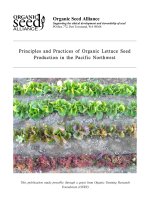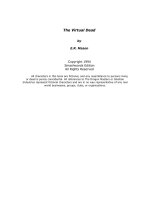The Algorithmic Beauty of Plants (The Virtual Laboratory) potx
Bạn đang xem bản rút gọn của tài liệu. Xem và tải ngay bản đầy đủ của tài liệu tại đây (15.97 MB, 240 trang )
Aristid Lindenmayer 1925–1989
Przemyslaw Prusinkiewicz
Aristid Lindenmayer
The Algorithmic Beauty
of Plants
With
James S. Hanan
F. David Fracchia
Deborah Fowler
MartinJ.M.deBoer
Lynn Mercer
With 150 Illustrations, 48 in Color
This edition of The Alogirthmic Beauty of Plants is the electronic version
of the book that was published by Springer-Verlag, New York, in 1990 and
reprinted in 1996. The electronic version has been produced using the orig-
inal L
A
T
E
X files and digital illustrations.
c
2004 Przemyslaw Prusinkiewicz
All rights reserved.
Front cover design: The roses in the foreground (Roses by D. R. Fowler,
J. Hanan and P. Prusinkiewicz [1990]) were modeled using L-systems. Dis-
tributed ray-tracing with one extended light source was used to simulate
depth of field. The roses were placed on a background image (photgraphy
by G. Rossbach), which was scanned digitally and post-processed.
Preface
The beauty of plants has attracted the attention of mathematicians for Mathematics
and beautycenturies. Conspicuous geometric features such as the bilateral sym-
metry of leaves, the rotational symmetry of flowers, and the helical
arrangements of scales in pine cones have been studied most exten-
sively. This focus is reflected in a quotation from Weyl [159, page 3],
“Beauty is bound up with symmetry.”
This book explores two other factors that organize plant structures
and therefore contribute to their beauty. The first is the elegance and
relative simplicity of developmental algorithms, that is, the rules which
describe plant development in time. The second is self-similarity,char-
acterized by Mandelbrot [95, page 34] as follows:
When each piece of a shape is geometrically similar to the
whole, both the shape and the cascade that generate it are
called self-similar.
This corresponds with the biological phenomenon described by Herman,
Lindenmayer and Rozenberg [61]:
In many growth processes of living organisms, especially of
plants, regularly repeated appearances of certain multicel-
lular structures are readily noticeable In the case of a
compound leaf, for instance, some of the lobes (or leaflets),
which are parts of a leaf at an advanced stage, have the
same shape as the whole leaf has at an earlier stage.
Thus, self-similarity in plants is a result of developmental processes. Growth and
formBy emphasizing the relationship between growth and form, this book
follows a long tradition in biology. D’Arcy Thompson [143] traces its
origins to the late seventeenth century, and comments:
Organic form itself is found, mathematically speaking, to be
a function of time We might call the form of an organism
an event in space-time, and not merely a configuration in
space.
This concept is echoed by Hall´e, Oldeman and Tomlinson [58]:
The idea of the form implicitly contains also the history of
such a form.
vi Preface
The developmental processes are captured using the formalism of
L-systems. They were introduced in 1968 by Lindenmayer [82] as aModeling of
plants theoretical framework for studying the development of simple multicel-
lular organisms, and subsequently applied to investigate higher plants
and plant organs. After the incorporation of geometric features, plant
models expressed using L-systems became detailed enough to allow the
use of computer graphics for realistic visualization of plant structures
and developmental processes.
The emphasis on graphics has several motivations. A visual compar-
ison of models with real structures is an important component of model
validation. The display of parameters and processes not observable di-
rectly in living organisms may assist in the analysis of their physiology,
and thus present a valuable tool for educational purposes. From an
aesthetic perspective, plants present a wealth of magnificent objects
for image synthesis. The quest for photorealism challenges modeling
and rendering algorithms, while a departure from realism may offer a
fresh view of known structures.
The application of computer graphics to biological structures is only
one of many factors that contribute to the interdisciplinary character
of this book. For example, the notion of L-systems is a part of formal
language theory, rooted in the theory of algorithms. The application of
L-systems to plant description has been studied by biologists, and in-
volves various methods of general mathematics. Self-similarity relates
plant structures to the geometry of fractals. Computer-aided visual-
ization of these structures, and the processes that create them, joins
science with art.
The study of an area that combines so many disciplines is very stim-About the book
ulating. Some results may be of special interest to students of biology
or computer graphics, but a much wider circle of readers, generally in-
terested in science, may find mathematical plant models inspiring, and
the open problems worth further thought. Consequently, all basic con-
cepts are presented in a self-contained manner, assuming only general
knowledge of mathematics at the junior college level.
This book focuses on original research results obtained by the au-
thors in the scope of the cooperation between the Theoretical Biology
Group, directed by Aristid Lindenmayer at the University of Utrecht,
and the Computer Graphics Group, working under the supervision of
Przemyslaw Prusinkiewicz at the University of Regina. Technically, the
book evolved from the SIGGRAPH ’88 and ’89 course notes Linden-
mayer systems, fractals, and plants, published by Springer-Verlag in
the series Lecture Notes in Biomathematics [112]. The present volume
has been extended with edited versions of recent journal and conference
papers (see Sources), as well as previously unpublished results.
Aristid Lindenmayer is the author of the notion of L-systems which
forms the main thread of the book. He also played an essential role
in the reported research by suggesting topics for study, guiding the
construction of specific plant models, monitoring their correctness and
Preface vii
participating in many discussions of biological and mathematical prob-
lems. Seriously ill, Professor Lindenmayer co-authored and edited sev-
eral chapters, but was not able to participate in the completion of this
work. If any inaccuracies or mistakes remain, he could not prevent
them. Still, in spite of unavoidable shortcomings, we hope that this
book will convey his and our excitement of applying mathematics to
explore the beauty of plants.
viii Preface
Acknowledgements
While preparing this book, we received extraordinary support and help
from many people, and we are deeply thankful to all of them. First
of all, we would like to thank those who were directly involved in the
underlying research and software development. Craig Kolb wrote the
ray tracer rayshade used to render many of the images included in
the book. Allan Snider developed several software tools, including a
previewer for rayshade, and provided valuable expertise in ray-tracing.
Daryl Hepting developed software for rendering sets defined by iterated
function systems and provided diagrams for Chapter 8. Norma Fuller
modeled several man-made objects incorporated into the images.
We would like to thank Zdzislaw Pawlak and Grzegorz Rozenberg
who initiated the contact between the Theoretical Biology Group at
the University of Utrecht and the Computer Graphics Group at the
University of Regina. Benoit Mandelbrot and Heinz-Otto Peitgen made
it possible to conduct parts of the reported research at Yale University
and the University of Bremen.
We are also grateful to all those who shared their knowledge with
us and made suggestions reflected in this book. Discussions and corre-
spondence with Jules Bloomenthal, Mark de Does, Pauline Hogeweg,
Jacqueline and Hermann L¨uck, Gavin Miller, Laurie Reuter, Dietmar
Saupe and Alvy Ray Smith were particularly fruitful.
Research reported in this book was funded by grants from the Nat-
ural Sciences and Engineering Research Council of Canada, as well as
an equipment donation and a research grant from Apple Computer,
Inc. We are particularly grateful to Mark Cutter for making the sup-
port from Apple possible. The Graphics Laboratory at the University
of Regina also enjoys continued support from the university. The influ-
ence of Lawrence Symes and R. Brien Maguire is deeply appreciated.
In addition, the University of Regina and the University of Utrecht
contributed towards travel expenses.
We would like to thank Springer-Verlag and in particular, Gerhard
Rossbach and Nina LaVoy from the Springer West Coast Office, for the
expedient publishing of this book.
Finally, we would like to thank our families and friends for their
love, support and patience while we worked on this book.
Przemyslaw Prusinkiewicz
James Hanan
F. David Fracchia
Deborah R. Fowler
Martin J. M. de Boer
Lynn Mercer
Regina, Canada
May 1990
Sources ix
Sources
In the preparation of this book, edited parts of the following publica-
tions were used:
• P. Prusinkiewicz and J. Hanan. Lindenmayer systems, fractals,
and plants,volume79ofLecture Notes in Biomathematics.
Springer-Verlag, Berlin, 1989. [Chapters 1, 3, 5]
• P. Prusinkiewicz, A. Lindenmayer and J. Hanan. Developmen-
tal models of herbaceous plants for computer imagery purposes.
Proceedings of SIGGRAPH ’88 (Atlanta, Georgia, August 1-5,
1988), in Computer Graphics, 22(4):141–150, 1988. Used with the
permission of the Association for Computing Machinery. [Chap-
ters 1, 3, 5]
• P. Prusinkiewicz and J. Hanan. Visualization of botanical struc-
tures and processes using parametric L-systems. In D. Thal-
mann, editor, Scientific visualization and graphics simulation,
pages 183–201. J. Wiley & Sons, 1990. [Chapters 1–5]
• D. Fowler, J. Hanan and P. Prusinkiewicz. Modelling spiral phyl-
lotaxis. computers & graphics, 13(3):291–296, 1989. [Chapter 4]
• J. S. Hanan. PLANTWORKS: A software system for realistic
plant modelling. Master’s thesis, University of Regina, 1988.
[Chapter 5]
• F. D. Fracchia, P. Prusinkiewicz and M. J. M. de Boer. Animation
of the development of multicellular structures. In N. Magnenat-
Thalmann and D. Thalmann, editors, Computer Animation ’90,
pages 3–18. Springer-Verlag, Tokyo, 1990. [Chapter 7]
• F. D. Fracchia, P. Prusinkiewicz, and M. J. M. de Boer. Visualiza-
tion of the development of multicellular structures. In Proceedings
of Graphics Interface ’90, pages 267–277, 1990. [Chapter 7]
• L. Mercer, P. Prusinkiewicz, and J. Hanan. The concept and de-
sign of a virtual laboratory. In Proceedings of Graphics Interface
’90, pages 149–155, 1990. [Appendix 8.2]
Contents
1 Graphical modeling using L-systems 1
1.1 Rewritingsystems 1
1.2 DOL-systems 3
1.3 Turtleinterpretationofstrings 6
1.4 SynthesisofDOL-systems 11
1.4.1 Edgerewriting 11
1.4.2 Noderewriting 13
1.4.3 Relationship between edge and
noderewriting 18
1.5 Modelinginthreedimensions 18
1.6 Branchingstructures 21
1.6.1 Axialtrees 21
1.6.2 TreeOL-systems 23
1.6.3 BracketedOL-systems 24
1.7 StochasticL-systems 28
1.8 Context-sensitiveL-systems 30
1.9 Growthfunctions 36
1.10ParametricL-systems 40
1.10.1 ParametricOL-systems 41
1.10.2 Parametric2L-systems 43
1.10.3 Turtle interpretation of parametric words . . . . . 46
2 Modeling of trees 51
3 Developmental models of herbaceous plants 63
3.1 Levels of model specification . . . . . . . . . . . . . . . . 64
3.1.1 PartialL-systems 64
3.1.2 Controlmechanismsinplants 65
3.1.3 Completemodels 68
3.2 Branchingpatterns 70
3.3 Modelsofinflorescences 71
3.3.1 Monopodialinflorescences 71
3.3.2 Sympodialinflorescences 82
3.3.3 Polypodialinflorescences 86
3.3.4 Modifiedracemes 93
xii Contents
4 Phyllotaxis 99
4.1 Theplanarmodel 100
4.2 Thecylindricalmodel 109
5 Models of plant organs 119
5.1 Predefinedsurfaces 119
5.2 Developmentalsurfacemodels 120
5.3 Modelsofcompoundleaves 128
6 Animation of plant development 133
6.1 TimedDOL-systems 135
6.2 Selectionofgrowthfunctions 139
6.2.1 Development of nonbranching filaments . . . . . . 140
6.2.2 Development of branching structures . . . . . . . 142
7 Modeling of cellular layers 145
7.1 MapL-systems 145
7.2 Graphicalinterpretationofmaps 150
7.3 Microsorium linguaeforme . . . . . . . . . . . . . . . . . 153
7.4 Dryopteristhelypteris 162
7.5 Modelingsphericalcelllayers 166
7.6 Modeling3Dcellularstructures 168
8 Fractal properties of plants 175
8.1 Symmetryandself-similarity 177
8.2 Plant models and iterated function systems . . . . . . . . 178
Epilogue 191
Appendix A Software environment for plant modeling 193
A.1 A virtual laboratory in botany . . . . . . . . . . . . . . . 193
A.2 List of laboratory programs . . . . . . . . . . . . . . . . 198
Appendix B About the figures 201
Appendix C Turtle interpretation of symbols 209
Bibliography 211
Index 225
Chapter 1
Graphical modeling using
L-systems
Lindenmayer systems — or L-systems for short — were conceived as
a mathematical theory of plant development [82]. Originally, they did
not include enough detail to allow for comprehensive modeling of higher
plants. The emphasis was on plant topology, that is, the neighborhood
relations between cells or larger plant modules. Their geometric aspects
were beyond the scope of the theory. Subsequently, several geometric
interpretations of L-systems were proposed with a view to turning them
into a versatile tool for plant modeling. Throughout this book, an
interpretation based on turtle geometry is used [109]. Basic notions
related to L-system theory and their turtle interpretation are presented
below.
1.1 Rewriting systems
The central concept of L-systems is that of rewriting. In general, rewrit-
ing is a technique for defining complex objects by successively replacing
parts of a simple initial object using a set of rewriting rules or produc-
tions. The classic example of a graphical object defined in terms of
rewriting rules is the snowflake curve (Figure 1.1), proposed in 1905 by Koch
constructionvon Koch [155]. Mandelbrot [95, page 39] restates this construction as
follows:
One begins with two shapes,aninitiator and a generator.
The latter is an oriented broken line made up of N equal
sides of length r. Thus each stage of the construction begins
with a broken line and consists in replacing each straight
interval with a copy of the generator, reduced and displaced
so as to have the same end points as those of the interval
being replaced.
2 Chapter 1. Graphical modeling using L-systems
initiator
generator
Figure 1.1: Construction of the snowflake curve
While the Koch construction recursively replaces open polygons, rewrit-
ing systems that operate on other objects have also been investigated.
For example, Wolfram [160, 161] studied patterns generated by rewrit-
ing elements of rectangular arrays. A similar array-rewriting mecha-
nism is the cornerstone of Conway’s popular game of life [49, 50]. An
important body of research has been devoted to various graph-rewriting
systems [14, 33, 34].
The most extensively studied and the best understood rewriting sys-Grammars
tems operate on character strings. The first formal definition of such a
system was given at the beginning of this century by Thue [128], but
a wide interest in string rewriting was spawned in the late 1950s by
Chomsky’s work on formal grammars [13]. He applied the concept of
rewriting to describe the syntactic features of natural languages. A
few years later Backus and Naur introduced a rewriting-based notation
in order to provide a formal definition of the programming language
ALGOL-60 [5, 103]. The equivalence of the Backus-Naur form (BNF)
and the context-free class of Chomsky grammars was soon recognized
[52], and a period of fascination with syntax, grammars and their appli-
cation to computer science began. At the center of attention were sets
of strings — called formal languages — and the methods for generating,
recognizing and transforming them.
In 1968 a biologist, Aristid Lindenmayer, introduced a new type ofL-systems
string-rewriting mechanism, subsequently termed L-systems [82]. The
essential difference between Chomsky grammars and L-systems lies in
1.2. DOL-systems 3
Figure 1.2: Relations between Chomsky classes of languages and language
classes generated by L-systems. The symbols OL and IL denote language
classes generated by context-free and context-sensitive L-systems, respec-
tively.
the method of applying productions. In Chomsky grammars produc-
tions are applied sequentially, whereas in L-systems they are applied
in parallel and simultaneously replace all letters in a given word. This
difference reflects the biological motivation of L-systems. Productions
are intended to capture cell divisions in multicellular organisms, where
many divisions may occur at the same time. Parallel production ap-
plication has an essential impact on the formal properties of rewriting
systems. For example, there are languages which can be generated
by context-free L-systems (called OL-systems) but not by context-free
Chomsky grammars [62, 128] (Figure 1.2).
1.2 DOL-systems
This section presents the simplest class of L-systems, those which are
deterministic and context-free, called DOL-systems. The discussion
starts with an example that introduces the main idea in intuitive terms.
Consider strings (words) built of two letters a and b,whichmay Example
occur many times in a string. Each letter is associated with a rewriting
rule. The rule a → ab means that the letter a is to be replaced by
the string ab, and the rule b → a means that the letter b is to be
replaced by a. The rewriting process starts from a distinguished string
called the axiom. Assume that it consists of a single letter b.Inthe
first derivation step (the first step of rewriting) the axiom b is replaced
4 Chapter 1. Graphical modeling using L-systems
Figure 1.3: Example of a derivation in a DOL-system
by a using production b → a. In the second step a is replaced by ab
using production a → ab.Thewordab consists of two letters, both of
which are simultaneously replaced in the next derivation step. Thus, a
is replaced by ab, b is replaced by a, and the string aba results. In a
similar way, the string aba yields abaab which in turn yields abaababa,
then abaababaabaab, and so on (Figure 1.3).
Formal definitions describing DOL-systems and their operation are
given below. For more details see [62, 127].
Let V denote an alphabet, V
∗
the set of all words over V ,andL-system
V
+
the set of all nonempty words over V .Astring OL-system is an
ordered triplet G = V,ω,P where V is the alphabet of the system,
ω ∈ V
+
is a nonempty word called the axiom and P ⊂ V × V
∗
is a
finite set of productions. A production (a, χ) ∈ P is written as a →
χ. The letter a and the word χ are called the predecessor and the
successor of this production, respectively. It is assumed that for any
letter a ∈ V , there is at least one word χ ∈ V
∗
such that a → χ.If
no production is explicitly specified for a given predecessor a ∈ V ,the
identity production a → a is assumed to belong to the set of productions
P . An OL-system is deterministic (noted DOL-system) if and only if
for each a ∈ V there is exactly one χ ∈ V
∗
such that a → χ.
Let µ = a
1
a
m
be an arbitrary word over V .Thewordν =Derivation
χ
1
χ
m
∈ V
∗
is directly derived from (or generated by) µ,notedµ ⇒
ν, if and only if a
i
→ χ
i
for all i =1, ,m.Awordν is generated by
G in a derivation of length n if there exists a developmental sequence of
words µ
0
,µ
1
, ,µ
n
such that µ
0
= ω, µ
n
= ν and µ
0
⇒ µ
1
⇒ ⇒
µ
n
.
1.2. DOL-systems 5
Figure 1.4: Development of a filament (Anabaena catenula) simulated using
a DOL-system
The following example provides another illustration of the operation of Anabaena
DOL-systems. The formalism is used to simulate the development of a
fragment of a multicellular filament such as that found in the blue-green
bacteria Anabaena catenula and various algae [25, 84, 99]. The symbols
a and b represent cytological states of the cells (their size and readiness
to divide). The subscripts l and r indicate cell polarity, specifying the
positions in which daughter cells of type a and b will be produced. The
development is described by the following L-system:
ω : a
r
p
1
: a
r
→ a
l
b
r
p
2
: a
l
→ b
l
a
r
p
3
: b
r
→ a
r
p
4
: b
l
→ a
l
(1.1)
Starting from a single cell a
r
(the axiom), the following sequence of
words is generated:
a
r
a
l
b
r
b
l
a
r
a
r
a
l
a
l
b
r
a
l
b
r
b
l
a
r
b
l
a
r
a
r
b
l
a
r
a
r
···
6 Chapter 1. Graphical modeling using L-systems
Under a microscope, the filaments appear as a sequence of cylin-
ders of various lengths, with a-type cells longer than b-type cells. The
corresponding schematic image of filament development is shown in
Figure 1.4. Note that due to the discrete nature of L-systems, the con-
tinuous growth of cells between subdivisions is not captured by this
model.
1.3 Turtle interpretation of strings
The geometric interpretation of strings applied to generate schematic
images of Anabaena catenula is a very simple one. Letters of the
L-system alphabet are represented graphically as shorter or longer rect-
angles with rounded corners. The generated structures are one-dimen-
sional chains of rectangles, reflecting the sequence of symbols in the
corresponding strings.
In order to model higher plants, a more sophisticated graphical in-Previous
methods terpretation of L-systems is needed. The first results in this direction
were published in 1974 by Frijters and Lindenmayer [46], and Hogeweg
and Hesper [64]. In both cases, L-systems were used primarily to de-
termine the branching topology of the modeled plants. The geometric
aspects, such as the lengths of line segments and the angle values, were
added in a post-processing phase. The results of Hogeweg and Hesper
were subsequently extended by Smith [136, 137], who demonstrated the
potential of L-systems for realistic image synthesis.
Szilard and Quinton [141] proposed a different approach to L-system
interpretation in 1979. They concentrated on image representations
with rigorously defined geometry, such as chain coding [43], and showed
that strikingly simple DOL-systems could generate the intriguing, con-
voluted curves known today as fractals [95]. These results were sub-
sequently extended in several directions. Siromoney and Subrama-
nian [135] specified L-systems which generate classic space-filling curves.
Dekking investigated the limit properties of curves generated by L-
systems [32] and concentrated on the problem of determining the fractal
(Hausdorff) dimension of the limit set [31]. Prusinkiewicz focused on
an interpretation based on a LOGO-style turtle [1] and presented more
examples of fractals and plant-like structures modeled using L-systems
[109, 111]. Further applications of L-systems with turtle interpretation
include realistic modeling of herbaceous plants [117], description of ko-
lam patterns (an art form from Southern India) [112, 115, 133, 134],
synthesis of musical scores [110] and automatic generation of space-
filling curves [116].
The basic idea of turtle interpretation is given below. A state of theTurtle
turtle is defined as a triplet (x, y, α), where the Cartesian coordinates
(x, y) represent the turtle’s position, and the angle α, called the heading,
is interpreted as the direction in which the turtle is facing. Given
the step size d and the angle increment δ, the turtle can respond to
1.3. Turtle interpretation of strings 7
Figure 1.5: (a) Turtle interpretation of string symbols F ,+,−. (b) Inter-
pretation of a string. The angle increment δ is equal to 90
◦
. Initially the
turtle faces up.
commands represented by the following symbols (Figure 1.5a):
F Move forward a step of length d. The state of the turtle
changes to (x
,y
,α), where x
= x + d cos α and y
=
y + d sin α. A line segment between points (x, y)and
(x
,y
)isdrawn.
f Move forward a step of length d without drawing a line.
+ Turn left by angle δ. The next state of the turtle is
(x, y, α+δ). The positive orientation of angles is counter-
clockwise.
− Turn right by angle δ. The next state of the turtle is
(x, y, α − δ).
Given a string ν, the initial state of the turtle (x
0
,y
0
,α
0
) and fixed Interpretation
parameters d and δ,theturtle interpretation of ν is the figure (set of
lines) drawn by the turtle in response to the string ν (Figure 1.5b).
Specifically, this method can be applied to interpret strings which are
generated by L-systems. For example, Figure 1.6 presents four approxi-
mations of the quadratic Koch island taken from Mandelbrot’s book [95,
page 51]. These figures were obtained by interpreting strings generated
by the following L-system:
ω : F −F − F −F
p : F → F − F + F + FF − F −F + F
The images correspond to the strings obtained in derivations of length
0to3. Theangleincrementδ isequalto90
◦
. The step length d is
decreased four times between subsequent images, making the distance
8 Chapter 1. Graphical modeling using L-systems
Figure 1.6: Generating a quadratic Koch island
between the endpoints of the successor polygon equal to the length of
the predecessor segment.
The above example reveals a close relationship between Koch con- Koch
constructions
vs. L-systems
structions and L-systems. The initiator corresponds to the axiom and
the generator corresponds to the production successor. The predeces-
sor F represents a single edge. L-systems specified in this way can be
perceived as codings for Koch constructions. Figure 1.7 presents further
examples of Koch curves generated using L-systems. A slight compli-
cation occurs if the curve is not connected; a second production (with
the predecessor f) is then required to keep components the proper dis-
tance from each other (Figure 1.8). The ease of modifying L-systems
makes them suitable for developing new Koch curves. For example, one
can start from a particular L-system and observe the results of insert-
ing, deleting or replacing some symbols. A variety of curves obtained
this way are shown in Figure 1.9.
1.3. Turtle interpretation of strings 9
Figure 1.7: Examples of Koch curves generated using L-systems: (a)
Quadratic Koch island [95, page 52], (b) A quadratic modification of the
snowflake curve [95, page 139]
Figure 1.8: Combination of islands and lakes [95, page 121]
10 Chapter 1. Graphical modeling using L-systems
Figure 1.9: A sequence of Koch curves obtained by successive modification
of the production successor
1.4. Synthesis of DOL-systems 11
a n=10, δ=90
◦
F
l
F
l
→F
l
+F
r
+
F
r
→-F
l
-F
r
b n=6, δ=60
◦
F
r
F
l
→F
r
+F
l
+F
r
F
r
→F
l
-F
r
-F
l
Figure 1.10: Examples of curves generated by edge-rewriting L-systems: (a)
the dragon curve [48], (b) the Sierpi´nski gasket [132]
1.4 Synthesis of DOL-systems
Random modification of productions gives little insight into the rela-
tionship between L-systems and the figures they generate. However,
we often wish to construct an L-system which captures a given struc-
ture or sequence of structures representing a developmental process.
This is called the inference problem in the theory of L-systems. Al-
though some algorithms for solving it were reported in the literature
[79, 88, 89], they are still too limited to be of practical value in the
modeling of higher plants. Consequently, the methods introduced be-
low are more intuitive in nature. They exploit two modes of operation
for L-systems with turtle interpretation, called edge rewriting and node
rewriting using terminology borrowed from graph grammars [56, 57, 87].
In the case of edge rewriting, productions substitute figures for poly-
gon edges, while in node rewriting, productions operate on polygon
vertices. Both approaches rely on capturing the recursive structure of
figures and relating it to a tiling of a plane. Although the concepts are
illustrated using abstract curves, they apply to branching structures
found in plants as well.
1.4.1 Edge rewriting
Edge rewriting can be viewed as an extension of Koch constructions.
For example, Figure 1.10a shows the dragon curve [21, 48, 95] and the
L-system that generated it. Both the F
l
and F
r
symbols represent
edges created by the turtle executing the “move forward” command.
The productions substitute F
l
or F
r
edges by pairs of lines forming
12 Chapter 1. Graphical modeling using L-systems
a
n=4, δ=60
◦
F
l
F
l
→F
l
+F
r
++F
r
-F
l
F
l
F
l
-F
r
+
F
r
→-F
l
+F
r
F
r
++F
r
+F
l
F
l
-F
r
b
n=2, δ=90
◦
-F
r
F
l
→F
l
F
l
-F
r
-F
r
+F
l
+F
l
-F
r
-F
r
F
l
+
F
r
+F
l
F
l
F
r
-F
l
+F
r
+F
l
F
l
+
F
r
-F
l
F
r
-F
r
-F
l
+F
l
+F
r
F
r
-
F
r
→+F
l
F
l
-F
r
-F
r
+F
l
+F
l
F
r
+F
l
-
F
r
F
r
-F
l
-F
r
+F
l
F
r
F
r
-F
l
-
F
r
F
l
+F
l
+F
r
-F
r
-F
l
+F
l
+F
r
F
r
Figure 1.11: Examples of FASS curves generated by edge-rewriting L-
systems: (a) hexagonal Gosper curve [51], (b) quadratic Gosper curve [32]
or E-curve [96]
left or right turns. Many interesting curves can be obtained assuming
two types of edges, “left” and “right.” Figures 1.10b and 1.11 present
additional examples.
The curves included in Figure 1.11 belong to the class of FASSFASS curve
construction curves (an acronym for space-f
illing, self-avoiding, simple and self-
s
imilar) [116], which can be thought of as finite, self-avoiding approxi-
mations of curves that pass through all points of a square (space-filling
curves [106]). McKenna [96] presented an algorithm for constructing
FASS curves using edge replacement. It exploits the relationship be-
tween such a curve and a recursive subdivision of a square into tiles.
For example, Figure 1.12 shows the tiling that corresponds to the E-
curve of Figure 1.11b. The polygon replacing an edge F
l
(Figure 1.12a)
approximately fills the square on the left side of F
l
(b). Similarly, the
polygon replacing an edge F
r
(c) approximately fills the square on the
right side of that edge (d). Consequently, in the next derivation step,
each of the 25 tiles associated with the curves (b) or (d) will be covered
by their reduced copies (Figure 1.11b). A recursive application of this
argument indicates that the whole curve is approximately space-filling.
It is also self-avoiding due to the following two properties:
1.4. Synthesis of DOL-systems 13
F
l
→F
l
F
l
+F
r
+F
r
-F
l
-F
l
+F
r
+F
r
F
l
-F
r
-F
l
F
l
F
r
+
F
l
-F
r
-F
l
F
l
-F
r
+F
l
F
r
+F
r
+F
l
-F
l
-F
r
F
r
+
F
r
→-F
l
F
l
+F
r
+F
r
-F
l
-F
l
F
r
-F
l
+F
r
F
r
+F
l
+F
r
-
F
l
F
r
F
r
+F
l
+F
r
F
l
-F
l
-F
r
+F
r
+F
l
-F
l
-F
r
F
r
Figure 1.12: Construction of the E-curve on the square grid. Left and right
edges are distinguished by the direction of ticks.
• the generating polygon is self-avoiding, and
• no matter what the relative orientation of the polygons lying on
two adjacent tiles, their union is a self-avoiding curve.
The first property is obvious, while the second can be verified by con-
sidering all possible relative positions of a pair of adjacent tiles.
Using a computer program to search the space of generating poly-
gons, McKenna found that the E-curve is the simplest FASS curve
obtained by edge replacement in a square grid. Other curves require
generators with more edges (Figure 1.13). The relationship between
edge rewriting and tiling of the plane extends to branching structures,
providing a method for constructing and analyzing L-systems which
operate according to the edge-rewriting paradigm (see Section 1.10.3).
1.4.2 Node rewriting
The idea of node rewriting is to substitute new polygons for nodes of the Subfigures
predecessor curve. In order to make this possible, turtle interpretation
is extended by symbols which represent arbitrary subfigures. As shown
in Figure 1.14, each subfigure A from a set of subfigures A is represented
by:
• two contact points, called the entry point P
A
and the exit point
Q
A
,and
• two direction vectors, called the entry vector p
A
and the exit vector
q
A
.
During turtle interpretation of a string ν,asymbolA ∈Aincorporates
the corresponding subfigure into a picture. To this end, A is translated









